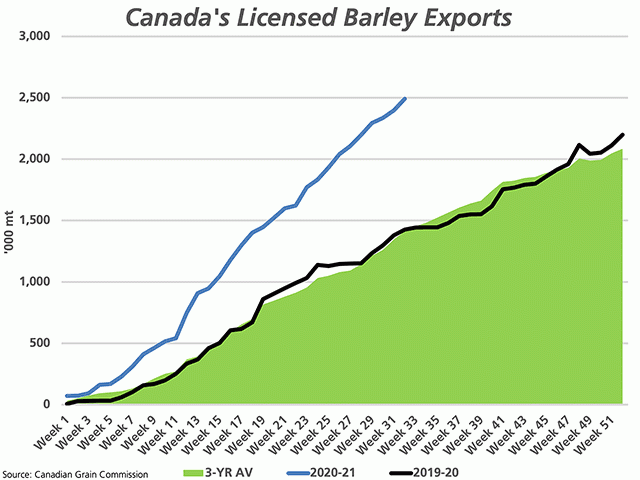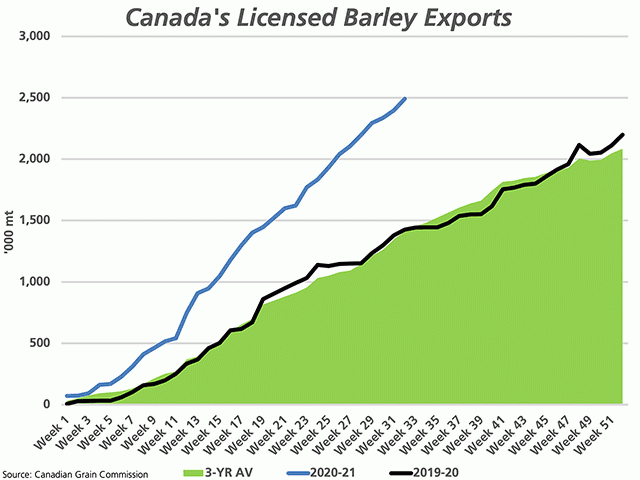Canada Markets
AAFC Tightens Barley Supply Balance
The Canadian Grain Commission reported 93,600 metric tons of barley exported in week 32, the week ending March 14. This is the highest volume shipped in three weeks. Year-to-date exports of barley through licensed terminals totals 2.4905 million metric tons during the first 32 weeks or 61.5% of the crop year, up 74.7% from the same period last crop year and 76.2% higher than the three-year average.
In addition, week 32 data shows commercial stocks of 520,300 mt, up 35% from the three-year average. Producer deliveries remain brisk with 121,400 mt delivered into the licensed handling system in week 32.
This comes at a time when the United States has reported four consecutive days of significant sales of corn to China for 2020-21 totaling 3.876 mmt, with DTN analysis prior to Friday's announcement of 800,000 mt sold indicating that crop year sales already total 91.4% of the USDA's export forecast for 2020-21, with a great deal of crop year left.
Two other news items this week bears watching. Despite reports of continued African swine fever reports in China during recent weeks, Rabobank has forecast that feed demand will rise 7% to 8% in 2021-22. A continued expansion in hog production along with higher slaughter weights reported are behind the forecast.
P[L1] D[0x0] M[300x250] OOP[F] ADUNIT[] T[]
In addition, the media reported this week that China's agriculture ministry is working on a plan to replace corn and soymeal consumption in feed rations with less-costly alternatives. Bloomberg reports that rice, wheat, potatoes, and other oilseed meals are being considered, but rest assured that barley is on this list. The challenge will be to replace the massive tons of corn and soybean imports. Reuters reports that during the first two months of 2021, corn imports total 4.8 mmt, up 414.4% from last year, while wheat imports are pegged at 2.48 mmt, up 265.1%. In contrast, barley imports from all sources are reported at 1.32 mmt during the first two months, up only 79.4%.
This month, Agriculture and Agri-Food Canada increased its forecast for 2020-21 barley exports by 100,000 mt to 3.7 mmt, including barley products. This would be the highest volume exported since 3.911 mmt was shipped in 2007-08, while would be a 25.3% increase from the previous year. This is the fourth increase in exports seen in five years and also the largest year-over-year percentage increase in exports seen since the 2007-08 crop year, a significant shock to the supply-demand balance and the domestic market.
In turn, AAFC has estimated 2020-21 ending stocks to fall by a further 100,000 mt to 600,000 mt. This would be the tightest stocks seen in Statistics Canada data going back to July 1981, reported as a record low by AAFC while representing 5.4% of annual use.
AAFC's March forecast points to a carbon copy of the current crop year in 2021-22, with a forecast 4.2% increase in seeded acres combined with an expected lower yield that is close to the five-year average leading to only a modest 200,000 mt increase ending stocks. Exports are estimated at 3.5 mmt, down 200,000 mt from the current year, while there is confusion in the data presented for domestic use. Commentary points to lower domestic use in 2020-21. The actual data tables show a 20,000 mt year-over-year increase in food and industrial use, a 75,000 mt year over-year increase in feed, waste, and dockage, while a 174,000 mt year-over-year drop in total domestic use, which doesn't add up.
While the potential may exist for an even greater increase in barley acres, one has to consider that ending stocks will also be tight for a number of competing crops such as canola, flax, lentils, and canary seed, providing opportunity for a number of other competing crops.
It appears that what-you-see is what-you-get in the barley market ahead. A broker tweet today pointed to southern Alberta business at a flat price for the September through April period. End users would be wise to have some coverage.
Cliff Jamieson can be reached at cliff.jamieson@dtn.com
Follow on Twitter @Cliff Jamieson
(c) Copyright 2021 DTN, LLC. All rights reserved.






Comments
To comment, please Log In or Join our Community .